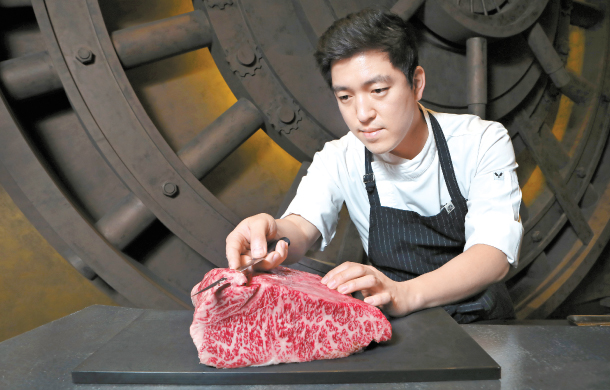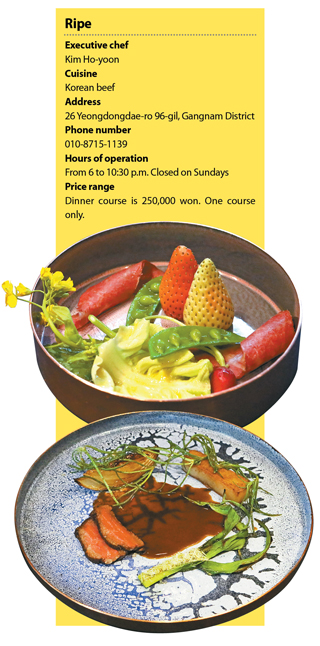Fresh vegetables bring out best in high-end beef

Chef Kim Ho-yoon of restaurant Ripe, above, cuts pieces of beef before serving it to guests. He also focuses on serving quality vegetables so that people visiting his restaurants for premium beef will also learn that some vegetables are worth paying a premium price for. [PARK SANG-MOON]
Chef Kim Ho-yoon of restaurant Ripe, located in Samseong-dong in southern Seoul’s Gangnam District, has been leading the charge to bring the Korean barbecue experience to another level. Dubbed beef course or, more commonly, beef omakase (using the Japanese word for food chosen by the house), the premium-style Korean barbecue with a diverse selection of beef parts is a growing trend in the dining industry. The restaurant chooses the hanwoo (Korean beef) and then Kim decides what parts to use and how to cook them to make the 250,000 won ($220) meal worthwhile.
“The biggest difference between this and the commonly-known barbecue is that we take different approaches to decide which part grills best on a pan or a straw fire,” said Kim, adding that pieces of beef with more fat are generally grilled on charcoal or straw fire, and pieces with less fat are cooked on a pan to keep them moist.
While putting the best beef upfront, the true charm of his restaurant Ripe and what differentiates his restaurants from others offering premium beef courses comes from his use of vegetables. Considering that people usually eat some kimchi or scallions while eating meat, Kim, who studied cooking Korean cuisine in school, presents a variety of vegetables that could match well with beef. The restaurant’s name Ripe shows Kim’s desire to not limit the menu to only beef at its best condition.

The very first dish, if you dine at the long bar table inside the restaurant, is made of vegetables, breaking with customers’ expectations that they will get beef as soon as they sit down. At the moment, guests are served with fresh strawberries as well as canola flowers and other greens that are in season, with a hint of vinegar. The move comes from Kim’s desire to show that vegetables can be as precious as beef.
“People see hanwoo as a premium ingredient and are willing to pay [a high price] for it, but they don’t really see vegetables in the same level,” said Kim. “I want people to see how tasty vegetables can be and remind them vegetables are also very precious ingredients. I’m making vegetables more appealing so that people will understand why they should also invest more in getting good vegetables as well as good meat.”
Some of his vegetables are seasoned with soy sauce that has been used for 18 years, and he pickles Korean radishes with a brine that’s been used for about six years. The same brine is used after all the radishes are eaten to make more.
Just as he gets ideas and ingredients from local farmers who know the vegetables much better than he does, Kim continues to seek collaborations with masters in other fields. He has been working with local charcutier Jo Woo-ram of Maison Jo, who specializes in curing pork, and has decided to make cured beef with condiments that are Korean and minimize the use of foreign condiments like cumin. The partners use soy sauce or perilla leaves to tone down the raw animal taste while curing and still are in the process of developing flavors.
“No matter what food I make, people will see me as a Korean chef because I am from Korea,” said Kim.
“What gets attention now is who uses what. I want to develop a diverse use of common ingredients in Korea, and that’s why I work with farmers who can bring me these quality items.”
To help diners in general understand and appreciate vegetables more, Kim thinks that early education about how things taste is important. His 10-year plan includes working on school lunches by making more business-to-business food products so that young children understand what good vegetables taste like and will look for quality when they are older.
He dreams about getting deeper in the agricultural industry as well as education. Later on, he wants to establish a school where a farmer can be trained with business skills in order to make the farming industry more profitable and appealing for future generations.
“I want the food-related industry to become where the money circulates because there needs to be a sizable economy to make people actually learn how to run their own business and make the industry continue to grow all together,” said Kim.
While he tries to make premium ingredients more appealing at Ripe, he also tries to offer more casual food at his other Italian restaurant Osteria Orzo in Hannam-dong in central Seoul’s Yongsan District. Orzo is where he spends most of his Sundays when Ripe is closed to see what people look for in casual food and figure out what he can do to appeal to a larger crowd at the restaurant.
BY LEE SUN-MIN [summerlee@joongang.co.kr]










with the Korea JoongAng Daily
To write comments, please log in to one of the accounts.
Standards Board Policy (0/250자)